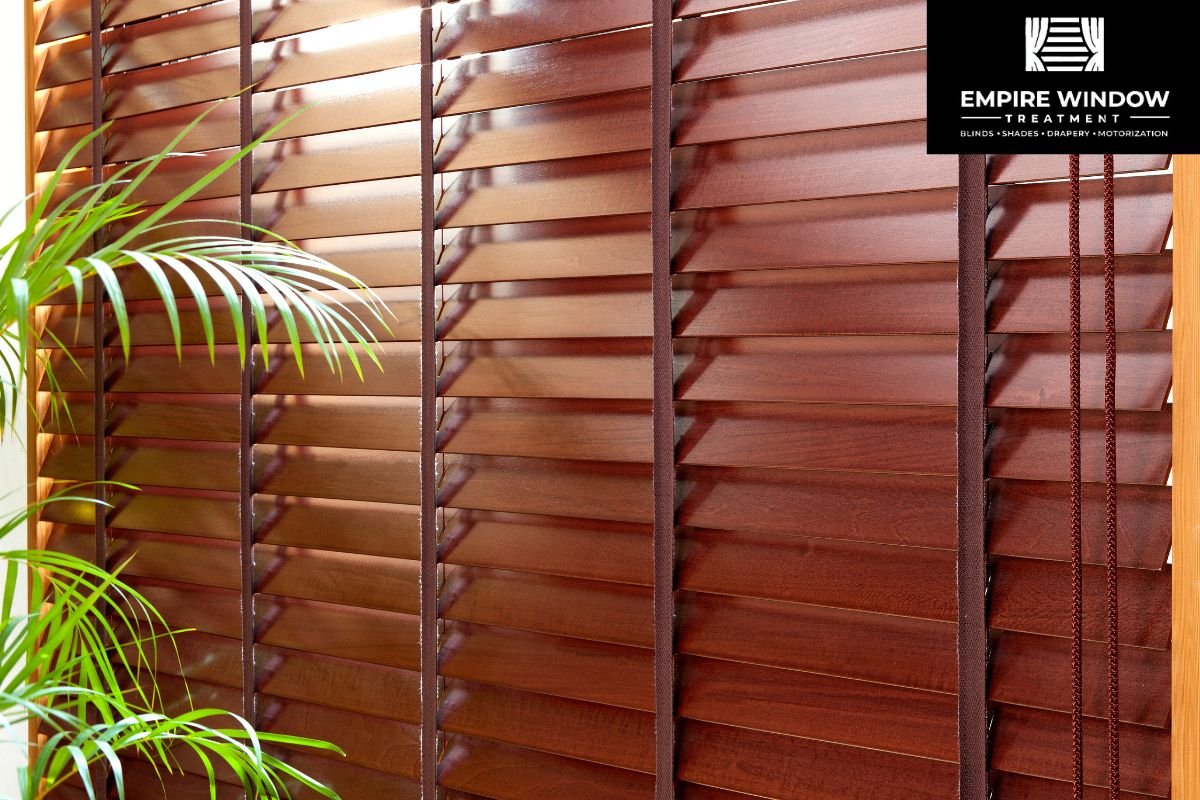Key Takeaways:
- Thicker materials insulate better – Look for dense or multi-layered fabrics like thermal roller blinds to block heat and cold
- More cells mean more insulation – Double or triple-cell honeycomb shades trap more air, offering better temperature control.
- Proper fit is essential – A tight fit, especially with outside mounts, helps block drafts and keeps your home more comfortable.
- Add side tracks for extra sealing – Side tracks and light gap blockers reduce air leaks around the edges for better insulation.
Keeping your home warm in winter and cool in summer can be tough and expensive. But did you know that your windows can make a big difference? That’s where insulation comes in. Insulation helps stop heat from escaping or getting in. And one simple way to add insulation to your windows is by using blinds.
Blinds don’t just look nice. They also help keep your home comfortable all year long. They block out cold drafts in the winter and stop too much heat from coming in during the summer. If you’ve ever wondered which blinds are best for insulation, this guide will help you find the perfect fit.
How Blinds Help with Insulation
Blinds do more than just block sunlight or add style—they also help keep your home comfortable. When closed, blinds trap a layer of air between your window and the room. This air works like a blanket, keeping warm air in during winter and blocking heat in summer.
Some blinds also stop cold drafts from coming through small cracks around your windows, which helps keep the room warm. In hot weather, blinds can block sunlight so your home doesn’t heat up as much, which helps your AC work less.
So, the right blinds can help save energy and make your home more cozy all year long.

Top Types of Blinds for Insulation
When it comes to keeping your home comfortable and energy-efficient, not all blinds are created equal. Some are specially designed to hold in heat during winter and keep it out during summer. Here are the top types of blinds that offer great insulation, each with its own style and benefits.
Cellular (Honeycomb) Shades
If you want the best insulation, cellular shades, also called honeycomb shades, are a top choice. These blinds have a unique shape that looks like a honeycomb when viewed from the side. The little pockets inside trap air, which creates a powerful barrier between your window and the room. You can choose from single, double, or even triple-cell designs depending on how much insulation you want. They work well in both warm and cold seasons and come in many colors and light-filtering options.
Dual Roller Blinds
Dual roller blinds give you the best of both worlds. They have two layers, usually a sheer blind and a blackout blind, built into one frame. You can switch between them based on how much light or privacy you want. But beyond looks, these layers also form a small air gap, which helps with insulation. If you’re looking for a modern, flexible window treatment that also helps with energy savings, this is a smart pick.
Thermal or Insulated Roller Blinds
These roller blinds are made with thick, tightly woven fabric that’s designed to block heat and cold. Many also come with a special backing, like a blackout lining, that adds even more warmth in winter. The design is sleek and simple, making it easy to match with any room style. They’re a good fit for people who want a clean look with strong insulating power.
Roman Shades with Thermal Lining
Roman shades are known for their soft, folding fabric style, but when you add a thermal lining, they do more than just decorate. The fabric traps layers of air as it folds, helping keep the room warmer or cooler. These shades are great if you want to mix function and fashion. They come in lots of colors and patterns, so you don’t have to give up style for comfort.
Wood and Faux Wood Blinds
Wood and faux wood blinds offer a natural, sturdy option for insulation. Their solid slats provide some protection against heat and cold, but they aren’t the most airtight. Because of small gaps between the slats, they work best when combined with another layer, like curtains or a shade. Still, they’re a nice choice if you like the warm look of wood and want a bit of extra insulation.
Draperies and Curtains with Thermal Backing
These may not be blinds in the traditional sense, but they’re a strong addition to your insulation plan. Drapes made with heavy fabric and thermal backing create a thick barrier over your windows. They’re especially helpful when paired with other blinds or shades. Plus, they come in tons of styles, so you can match them to any room while staying cozy and energy-efficient.
Each of these options has its own strengths. Whether you care most about looks, budget, or insulation power, there’s a window treatment that fits your needs. In the next section, we’ll look at which features make blinds even better at blocking out heat and cold.
Key Features That Boost Insulation
Choosing the right type of blind is important, but what really makes a difference are the features that help lock in warmth or block out heat. If you’re shopping for blinds that keep your home comfortable year-round, here are the key features to pay attention to.
Material Matters
Not all blind materials work the same. Thicker or layered fabrics do a better job of blocking heat and cold. For example, thermal roller blinds often use tightly woven fabric with special coatings that help stop temperature changes. When comparing, choose blinds that feel thick or have extra layers to trap air.
Cell Count in Honeycomb Shades
If you’re looking at cellular (honeycomb) shades, check how many “cells” they have. Single-cell shades offer some insulation, but double or triple-cell designs give more. More cells mean more air pockets, which give better protection from hot or cold air. If you live where winters or summers are extreme, more cells are worth it.
Fit and Mounting Style
How blinds fit your window matters a lot. A snug fit blocks air better. Inside mounts (set inside the window frame) look nice, but outside mounts (covering the edges) often stop drafts more. No matter which you choose, make sure the fit is tight. Loose blinds won’t insulate well.
Side Tracks and Light Gap Blockers
Even small gaps around blinds let in heat or cold. Side tracks and light gap blockers help seal the space between the blind and window frame. These add-ons trap air and help keep your room temperature steady. They’re great for windows that get a lot of sun or wind.
When you’re shopping for insulating blinds, keep these features in mind. The right combination of materials, design, and fit can make a huge difference, not just in comfort, but also in your energy bills.
Tips for Maximizing Insulation with Blinds
Even the best insulating blinds can do more when used the right way. With a few smart choices and small upgrades, you can get the most out of your window treatments.
Measure for a Snug Fit
Proper sizing is key. Blinds that don’t fit tightly can let cold air leak through the sides. Make sure to measure your windows carefully and choose a fit, inside or outside mount, that covers the window well and reduces drafts.
Layer with Curtains or Drapes
Pairing blinds with thick curtains or thermal drapes adds another layer of protection. This helps trap warm air in winter and block heat in summer. Plus, it gives you more control over light and privacy.
Use Smart or Motorized Controls
Smart blinds can open or close based on time or temperature. For example, you can set them to close at night to hold in heat or open during sunny mornings to let in warmth. It’s a simple way to save energy without thinking about it.
Seal Around the Window Frame
Even with good blinds, air can sneak in through gaps around the window. Use weatherstripping or caulk to seal any cracks. It’s a quick fix that boosts the overall insulation of your windows.
With the right fit, smart layering, and a few upgrades, your blinds can help keep your home more comfortable and energy-efficient all year long.
Additional Benefits of Insulating Blinds
Insulating blinds do more than just help with heat and cold. They offer several extra benefits that can improve your home’s comfort, protect your belongings, and even save you money in the long run.
Lower Energy Bills
Because insulating blinds help your home stay warmer in winter and cooler in summer, your heating and cooling systems don’t have to work as hard. That means lower energy use and lower utility bills. Over time, the savings can really add up, especially if you have lots of windows or live in an area with extreme temperatures.
Better Overall Comfort
Tired of cold spots near the windows? Insulating blinds help create a more even temperature throughout the room. They reduce sudden changes in heat or cold near the glass, making your space feel more stable and comfortable all day long.
Noise Reduction
Blinds made with thicker materials or layered designs can help block outside sounds, too. Whether you live near a busy road or just want a quieter space, insulating blinds can reduce noise levels and make your home feel more peaceful.
UV Protection for Furniture and Floors
Direct sunlight can fade your furniture, rugs, and hardwood floors over time. Many insulating blinds also block harmful UV rays, helping protect your home’s interior. This keeps your décor looking newer, longer, without needing to close the blinds completely and sit in the dark.
These added benefits make insulating blinds a smart upgrade for any home. You’re not just making your space more energy-efficient, you’re improving comfort, quiet, and even protecting what you already own
How to Choose the Right Blinds for Your Home
There are many great blinds that offer insulation, but how do you know which one is right for your home? It depends on a few important factors. Here’s what to think about before making your decision.
Consider Your Climate
Where you live plays a big role in which blinds will work best. If you’re in a colder area, look for blinds with stronger insulation, like double or triple-cell cellular shades. These traps more air and help hold in heat. If your climate is milder, a lighter option with some insulation might be enough to keep your home comfortable without overdoing it.
Think About Your Windows
Different windows need different solutions. Older, single-pane windows usually lose more heat and may need thicker or layered blinds for better insulation. Newer double-pane windows already offer some protection, so you might be able to use lighter or simpler blinds. Also, larger windows or sliding glass doors might need wider blinds or side tracks to cover more space.
Set a Budget That Works for You
Some insulating blinds cost more up front, but they can save you money in the long run through lower energy bills. It’s important to balance the cost of the blinds with how much you expect to save. If your budget is tight, look for options that offer decent insulation at a lower price, like thermal roller blinds or single-cell shades. You can always add layers later with curtains or drapes.
Match Your Style and Decor
Blinds are part of your home’s look, so choose a style that fits your space. Do you like a soft, cozy feel? Roman shades with fabric and thermal lining might be perfect. Prefer a clean and modern look? Try sleek roller blinds with a blackout layer. You can also find blinds in many colors, patterns, and finishes to match your furniture and walls.
When choosing insulating blinds, it’s not just about saving energy, it’s also about picking what works best for your space, windows, and lifestyle. With the right choice, you’ll enjoy both comfort and style all year long.
Your Next Step to a More Comfortable, Energy-Efficient Home
If you’re looking to improve comfort, cut down on energy costs, and protect your home from extreme temperatures, choosing the right blinds makes a big difference. Out of all the options, cellular shades are often the best choice for insulation, thanks to their unique design that traps air and blocks heat transfer.
But you don’t have to stop there. Combining different styles, like pairing cellular shades with thermal curtains, can give you even better results. And no matter what style you pick, the key to success is proper measurement and installation. A good fit helps seal out drafts and makes your blinds work as effectively as possible.
With the right blinds, smart features, and a few small upgrades, you can enjoy a more comfortable home all year long, while saving energy and money at the same time. Now that you know what to look for, you’re ready to make a smart, stylish, and energy-efficient choice for your windows.
Frequently Asked Questions (FAQ)
What types of blinds offer the best insulation?
Cellular (honeycomb) shades are the best for insulation. Their air-filled cells trap heat or cold, helping keep rooms warm in winter and cool in summer. Double or triple-cell options work even better.
How do insulating blinds help save energy?
They keep warm air inside during winter and block heat in the summer. This means your heater or AC doesn’t have to work as hard, lowering your energy bills.
Can insulating blinds reduce noise?
Yes. Thicker or layered blinds help block outside sounds, making your home quieter, especially helpful if you live near traffic or noisy neighbors.
Do I need a professional to install them?
Not always. Many people can install them on their own. But for big or oddly shaped windows, a pro can ensure a better fit and better insulation.
How do I take care of insulating blinds?
They’re easy to maintain. Just dust or vacuum them gently now and then. For spots or stains, wipe with a damp cloth and follow the care guide from the manufacturer.
Want To know
Want to learn more about window treatments?
Check out these helpful guides to find the perfect fit for your home:
12 Types of Window Treatments To Know
Shades vs Curtains: Which One Is Right For Your Home?
Types of Window Treatments for Bedrooms
What Window Treatments Are In Style for 2025?
Troubleshooting Motorized Blinds
Should Drapes Touch the Floor?
Do Window Treatments Increase Home Value?
Which Window Treatment Is Best?
Which Blinds Are Best for Blackout?
Explore more. Learn more. Love your windows.

